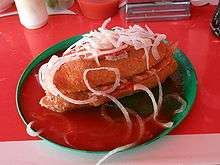Torta ahogada
A torta ahogada (Spanish pronunciation: [ˈtoɾta a.oˈɣaða], drowned submarine sandwich) is a typical dish from the Mexican state of Jalisco, particularly in the city of Guadalajara.[1] Although it is popular in some other parts of Mexico, it is most popular in Guadalajara. It is called "drowned" because the sandwich is submerged totally or partially in a sauce made primarily of a dried chili pepper called chile de árbol. Less spicy versions of the sandwich, made with a tomato-based sauce, are also available.
| Type | Sandwich |
|---|---|
| Place of origin | Mexico |
| Region or state | Guadalajara |
| Main ingredients | Birote salado bread (or bolillo depending on availability), sauce (dried chili peppers), fried pork or chicken or beans |
History

Tortas ahogadas are made with birote bread (a similar bread is called bolillo. In Jalisco, birote is only made in Guadalajara and towns nearby. The main difference besides the flavor is that birote has a thick crust), characteristic of the region. Specifically, it is made with birote salado, which has a thick, crunchy crust and softer interior, which is more salty than sweet. The consistency of the bread permits the sandwich to be submerged in sauce without crumbling or dissolving (which usually happens if using bolillo). The bread is sliced open on one side and the sandwich is filled with chopped, fried pork. Fillings of chicken, beans, and cheese are sometimes available. The sandwiches are served with onion rings, radishes, avocados and chili peppers.
The sauce can be either spicy or mild. The first is based on ground arbol chilies, vinegar, garlic, oregano, and other spices. Sweet sauce, which is considerably less spicy, is made of red tomatoes and chili peppers. If the sandwich is ordered "media ahogada" or "half drowned", it is dipped partially in the sauce. If the sandwich is "bien ahogada" or "well drowned", the bread and meat are completely submerged in the sauce until no bubbles emerge.
It is traditional to eat tortas ahogadas in Estadio Jalisco, the football stadium in Guadalajara, in spite of the difficulty in consuming them. They are usually eaten with bare hands, even though tortas ahogadas are messy due to the large amount of sauce used. This delicacy is usually available from street vendors, but it can also be found in restaurants.
The torta ahogada is often said to hold a special place in the hearts of many people who are from Guadalajara or have spent time there. Some people go to great lengths to seek out tortas ahogadas in places outside of the region. The people from Guadalajara claim that no one really visits Guadalajara without making a stop to try a torta ahogada.[2]
See also
References
- "Guadalajara". Somewhere Street. Japan. September 2012. NHK World. Retrieved September 1, 2016.
- "Ode to the Torta Ahogada". San Diego Union Tribune. Retrieved Aug 18, 2009.

